Comprehensive Report on Financial Management, Statements, and Ratios
VerifiedAdded on 2022/11/23
|11
|2917
|463
Report
AI Summary
This report provides a comprehensive overview of financial management, emphasizing its importance in corporate finance. It delves into the core concepts of financial planning, procurement, and utilization of funds, as well as the impact of financial decisions on organizational profitability. The report then explores the key components of financial statements, including income statements, balance sheets, and cash flow statements, and highlights the use of ratios for comparative analysis, decision-making, and forecasting. It includes a detailed balance sheet and business review, along with the calculation and interpretation of key financial ratios such as gross profit margin, net profit margin, current ratio, and quick ratio. The analysis demonstrates how these ratios are used to assess a company's financial health, solvency, and profitability, offering insights into its performance and financial leverage. The report concludes by illustrating the practical application of these financial tools in evaluating a company's performance and making informed business decisions.

Business
Paraphrase This Document
Need a fresh take? Get an instant paraphrase of this document with our AI Paraphraser
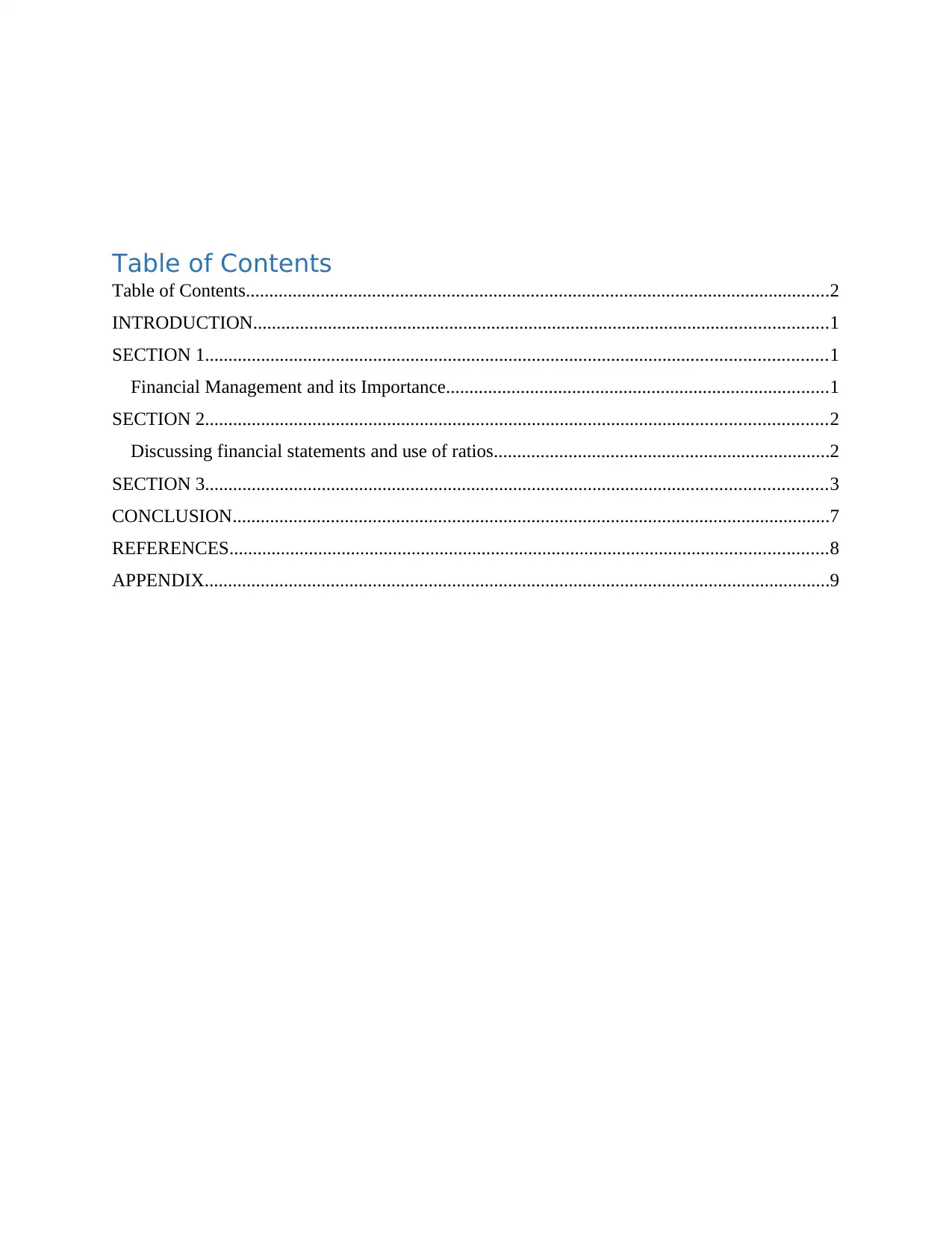
Table of Contents
Table of Contents.............................................................................................................................2
INTRODUCTION...........................................................................................................................1
SECTION 1.....................................................................................................................................1
Financial Management and its Importance..................................................................................1
SECTION 2.....................................................................................................................................2
Discussing financial statements and use of ratios........................................................................2
SECTION 3.....................................................................................................................................3
CONCLUSION................................................................................................................................7
REFERENCES................................................................................................................................8
APPENDIX......................................................................................................................................9
Table of Contents.............................................................................................................................2
INTRODUCTION...........................................................................................................................1
SECTION 1.....................................................................................................................................1
Financial Management and its Importance..................................................................................1
SECTION 2.....................................................................................................................................2
Discussing financial statements and use of ratios........................................................................2
SECTION 3.....................................................................................................................................3
CONCLUSION................................................................................................................................7
REFERENCES................................................................................................................................8
APPENDIX......................................................................................................................................9
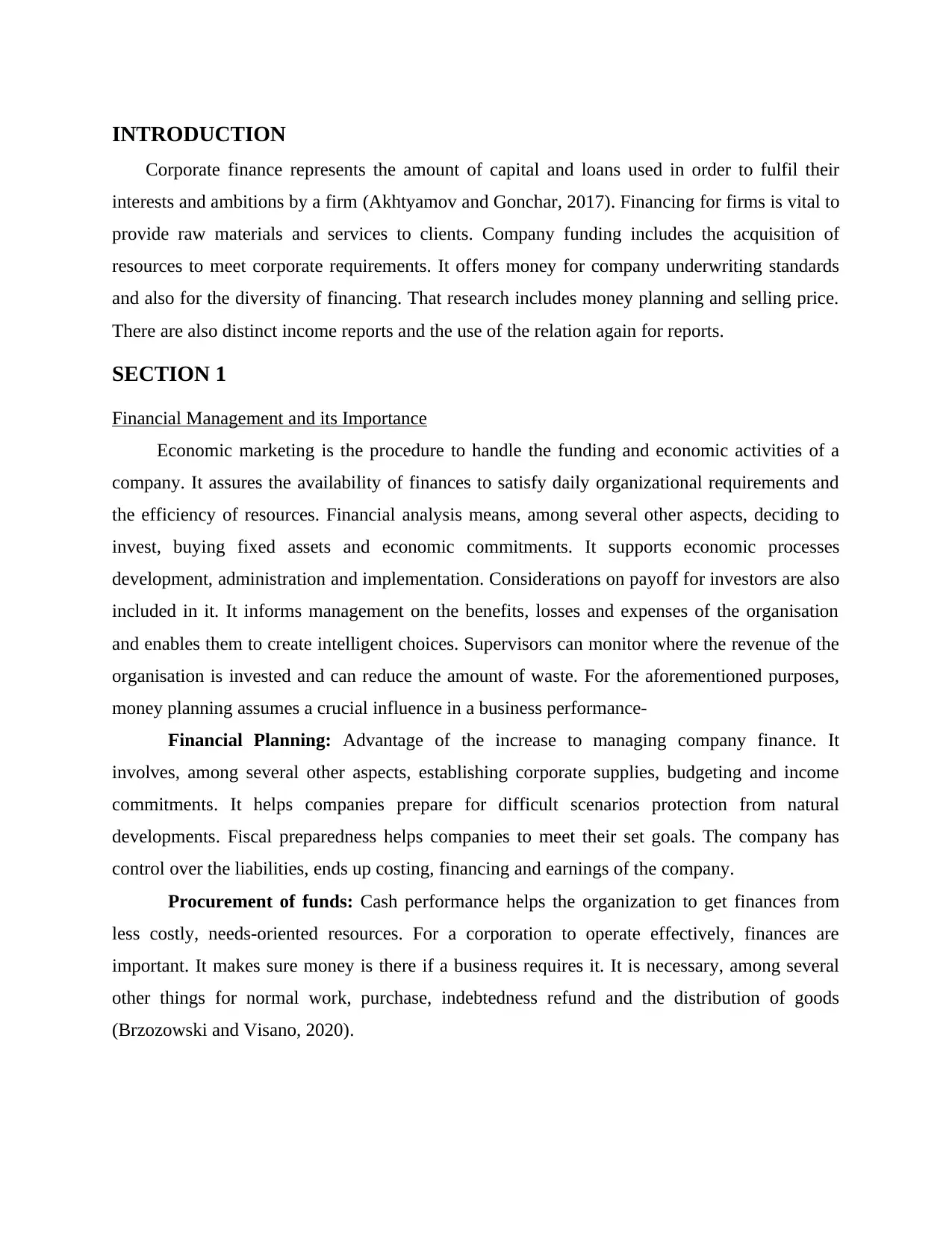
INTRODUCTION
Corporate finance represents the amount of capital and loans used in order to fulfil their
interests and ambitions by a firm (Akhtyamov and Gonchar, 2017). Financing for firms is vital to
provide raw materials and services to clients. Company funding includes the acquisition of
resources to meet corporate requirements. It offers money for company underwriting standards
and also for the diversity of financing. That research includes money planning and selling price.
There are also distinct income reports and the use of the relation again for reports.
SECTION 1
Financial Management and its Importance
Economic marketing is the procedure to handle the funding and economic activities of a
company. It assures the availability of finances to satisfy daily organizational requirements and
the efficiency of resources. Financial analysis means, among several other aspects, deciding to
invest, buying fixed assets and economic commitments. It supports economic processes
development, administration and implementation. Considerations on payoff for investors are also
included in it. It informs management on the benefits, losses and expenses of the organisation
and enables them to create intelligent choices. Supervisors can monitor where the revenue of the
organisation is invested and can reduce the amount of waste. For the aforementioned purposes,
money planning assumes a crucial influence in a business performance-
Financial Planning: Advantage of the increase to managing company finance. It
involves, among several other aspects, establishing corporate supplies, budgeting and income
commitments. It helps companies prepare for difficult scenarios protection from natural
developments. Fiscal preparedness helps companies to meet their set goals. The company has
control over the liabilities, ends up costing, financing and earnings of the company.
Procurement of funds: Cash performance helps the organization to get finances from
less costly, needs-oriented resources. For a corporation to operate effectively, finances are
important. It makes sure money is there if a business requires it. It is necessary, among several
other things for normal work, purchase, indebtedness refund and the distribution of goods
(Brzozowski and Visano, 2020).
Corporate finance represents the amount of capital and loans used in order to fulfil their
interests and ambitions by a firm (Akhtyamov and Gonchar, 2017). Financing for firms is vital to
provide raw materials and services to clients. Company funding includes the acquisition of
resources to meet corporate requirements. It offers money for company underwriting standards
and also for the diversity of financing. That research includes money planning and selling price.
There are also distinct income reports and the use of the relation again for reports.
SECTION 1
Financial Management and its Importance
Economic marketing is the procedure to handle the funding and economic activities of a
company. It assures the availability of finances to satisfy daily organizational requirements and
the efficiency of resources. Financial analysis means, among several other aspects, deciding to
invest, buying fixed assets and economic commitments. It supports economic processes
development, administration and implementation. Considerations on payoff for investors are also
included in it. It informs management on the benefits, losses and expenses of the organisation
and enables them to create intelligent choices. Supervisors can monitor where the revenue of the
organisation is invested and can reduce the amount of waste. For the aforementioned purposes,
money planning assumes a crucial influence in a business performance-
Financial Planning: Advantage of the increase to managing company finance. It
involves, among several other aspects, establishing corporate supplies, budgeting and income
commitments. It helps companies prepare for difficult scenarios protection from natural
developments. Fiscal preparedness helps companies to meet their set goals. The company has
control over the liabilities, ends up costing, financing and earnings of the company.
Procurement of funds: Cash performance helps the organization to get finances from
less costly, needs-oriented resources. For a corporation to operate effectively, finances are
important. It makes sure money is there if a business requires it. It is necessary, among several
other things for normal work, purchase, indebtedness refund and the distribution of goods
(Brzozowski and Visano, 2020).
⊘ This is a preview!⊘
Do you want full access?
Subscribe today to unlock all pages.

Trusted by 1+ million students worldwide
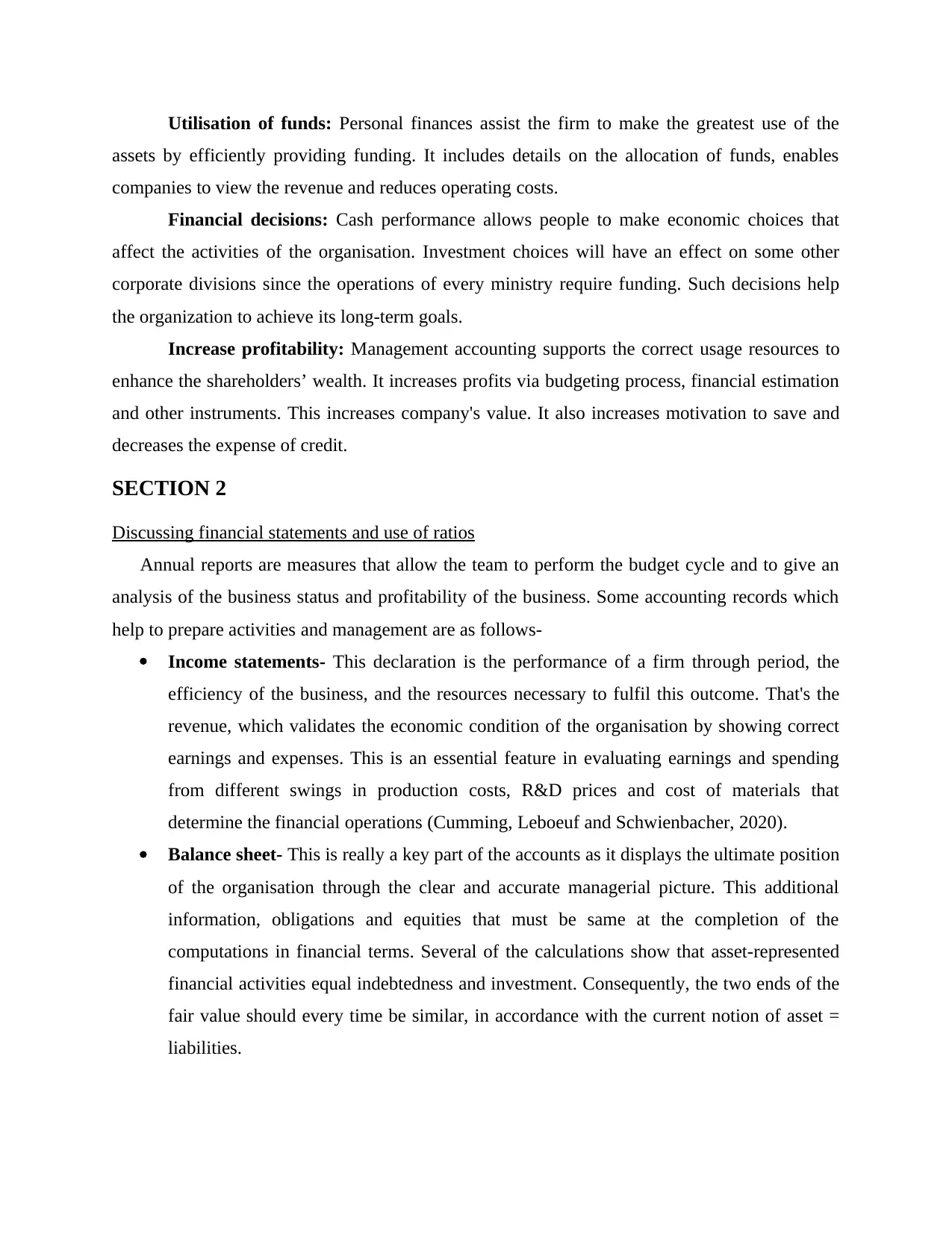
Utilisation of funds: Personal finances assist the firm to make the greatest use of the
assets by efficiently providing funding. It includes details on the allocation of funds, enables
companies to view the revenue and reduces operating costs.
Financial decisions: Cash performance allows people to make economic choices that
affect the activities of the organisation. Investment choices will have an effect on some other
corporate divisions since the operations of every ministry require funding. Such decisions help
the organization to achieve its long-term goals.
Increase profitability: Management accounting supports the correct usage resources to
enhance the shareholders’ wealth. It increases profits via budgeting process, financial estimation
and other instruments. This increases company's value. It also increases motivation to save and
decreases the expense of credit.
SECTION 2
Discussing financial statements and use of ratios
Annual reports are measures that allow the team to perform the budget cycle and to give an
analysis of the business status and profitability of the business. Some accounting records which
help to prepare activities and management are as follows-
Income statements- This declaration is the performance of a firm through period, the
efficiency of the business, and the resources necessary to fulfil this outcome. That's the
revenue, which validates the economic condition of the organisation by showing correct
earnings and expenses. This is an essential feature in evaluating earnings and spending
from different swings in production costs, R&D prices and cost of materials that
determine the financial operations (Cumming, Leboeuf and Schwienbacher, 2020).
Balance sheet- This is really a key part of the accounts as it displays the ultimate position
of the organisation through the clear and accurate managerial picture. This additional
information, obligations and equities that must be same at the completion of the
computations in financial terms. Several of the calculations show that asset-represented
financial activities equal indebtedness and investment. Consequently, the two ends of the
fair value should every time be similar, in accordance with the current notion of asset =
liabilities.
assets by efficiently providing funding. It includes details on the allocation of funds, enables
companies to view the revenue and reduces operating costs.
Financial decisions: Cash performance allows people to make economic choices that
affect the activities of the organisation. Investment choices will have an effect on some other
corporate divisions since the operations of every ministry require funding. Such decisions help
the organization to achieve its long-term goals.
Increase profitability: Management accounting supports the correct usage resources to
enhance the shareholders’ wealth. It increases profits via budgeting process, financial estimation
and other instruments. This increases company's value. It also increases motivation to save and
decreases the expense of credit.
SECTION 2
Discussing financial statements and use of ratios
Annual reports are measures that allow the team to perform the budget cycle and to give an
analysis of the business status and profitability of the business. Some accounting records which
help to prepare activities and management are as follows-
Income statements- This declaration is the performance of a firm through period, the
efficiency of the business, and the resources necessary to fulfil this outcome. That's the
revenue, which validates the economic condition of the organisation by showing correct
earnings and expenses. This is an essential feature in evaluating earnings and spending
from different swings in production costs, R&D prices and cost of materials that
determine the financial operations (Cumming, Leboeuf and Schwienbacher, 2020).
Balance sheet- This is really a key part of the accounts as it displays the ultimate position
of the organisation through the clear and accurate managerial picture. This additional
information, obligations and equities that must be same at the completion of the
computations in financial terms. Several of the calculations show that asset-represented
financial activities equal indebtedness and investment. Consequently, the two ends of the
fair value should every time be similar, in accordance with the current notion of asset =
liabilities.
Paraphrase This Document
Need a fresh take? Get an instant paraphrase of this document with our AI Paraphraser
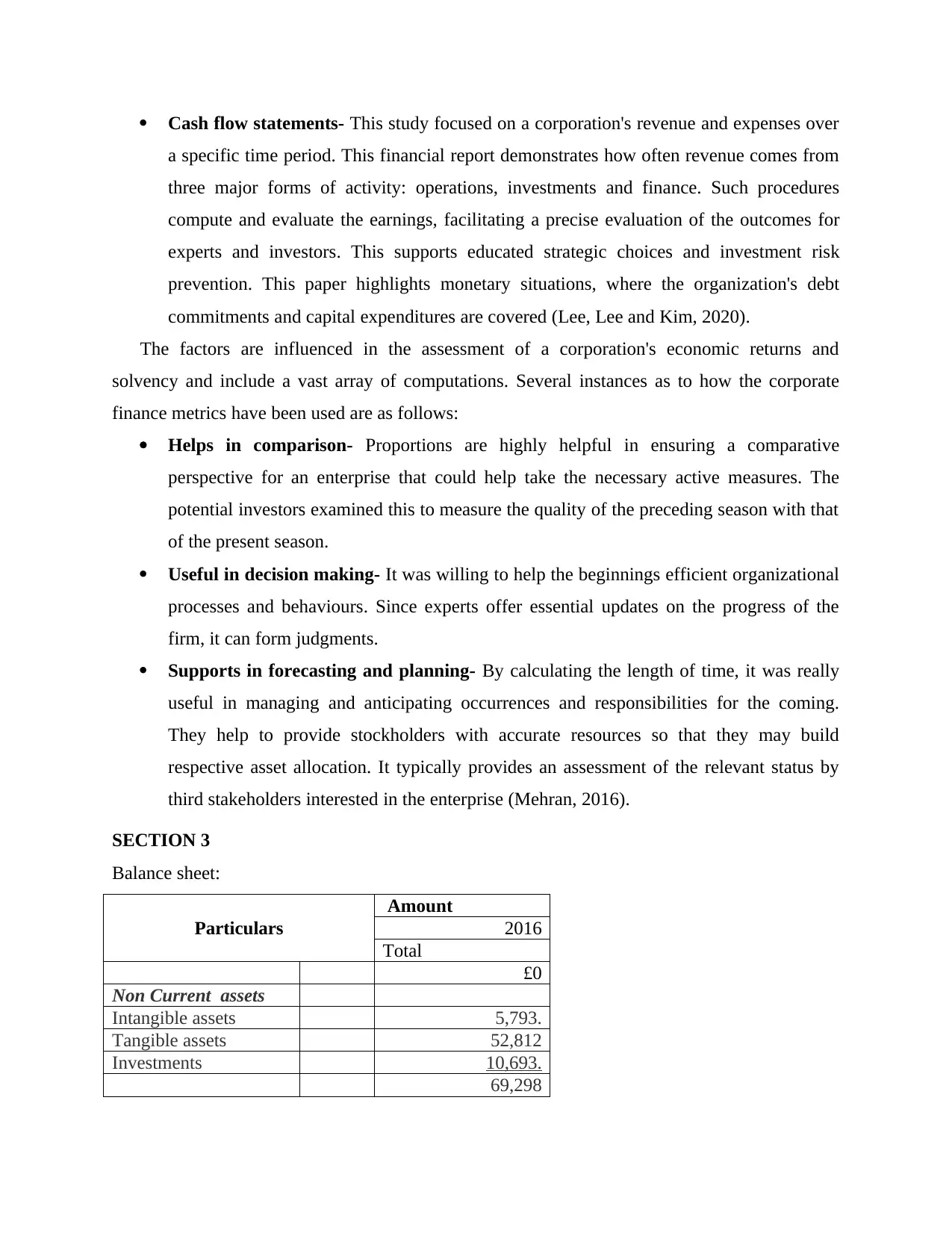
Cash flow statements- This study focused on a corporation's revenue and expenses over
a specific time period. This financial report demonstrates how often revenue comes from
three major forms of activity: operations, investments and finance. Such procedures
compute and evaluate the earnings, facilitating a precise evaluation of the outcomes for
experts and investors. This supports educated strategic choices and investment risk
prevention. This paper highlights monetary situations, where the organization's debt
commitments and capital expenditures are covered (Lee, Lee and Kim, 2020).
The factors are influenced in the assessment of a corporation's economic returns and
solvency and include a vast array of computations. Several instances as to how the corporate
finance metrics have been used are as follows:
Helps in comparison- Proportions are highly helpful in ensuring a comparative
perspective for an enterprise that could help take the necessary active measures. The
potential investors examined this to measure the quality of the preceding season with that
of the present season.
Useful in decision making- It was willing to help the beginnings efficient organizational
processes and behaviours. Since experts offer essential updates on the progress of the
firm, it can form judgments.
Supports in forecasting and planning- By calculating the length of time, it was really
useful in managing and anticipating occurrences and responsibilities for the coming.
They help to provide stockholders with accurate resources so that they may build
respective asset allocation. It typically provides an assessment of the relevant status by
third stakeholders interested in the enterprise (Mehran, 2016).
SECTION 3
Balance sheet:
Particulars
Amount
2016
Total
£0
Non Current assets
Intangible assets 5,793.
Tangible assets 52,812
Investments 10,693.
69,298
a specific time period. This financial report demonstrates how often revenue comes from
three major forms of activity: operations, investments and finance. Such procedures
compute and evaluate the earnings, facilitating a precise evaluation of the outcomes for
experts and investors. This supports educated strategic choices and investment risk
prevention. This paper highlights monetary situations, where the organization's debt
commitments and capital expenditures are covered (Lee, Lee and Kim, 2020).
The factors are influenced in the assessment of a corporation's economic returns and
solvency and include a vast array of computations. Several instances as to how the corporate
finance metrics have been used are as follows:
Helps in comparison- Proportions are highly helpful in ensuring a comparative
perspective for an enterprise that could help take the necessary active measures. The
potential investors examined this to measure the quality of the preceding season with that
of the present season.
Useful in decision making- It was willing to help the beginnings efficient organizational
processes and behaviours. Since experts offer essential updates on the progress of the
firm, it can form judgments.
Supports in forecasting and planning- By calculating the length of time, it was really
useful in managing and anticipating occurrences and responsibilities for the coming.
They help to provide stockholders with accurate resources so that they may build
respective asset allocation. It typically provides an assessment of the relevant status by
third stakeholders interested in the enterprise (Mehran, 2016).
SECTION 3
Balance sheet:
Particulars
Amount
2016
Total
£0
Non Current assets
Intangible assets 5,793.
Tangible assets 52,812
Investments 10,693.
69,298
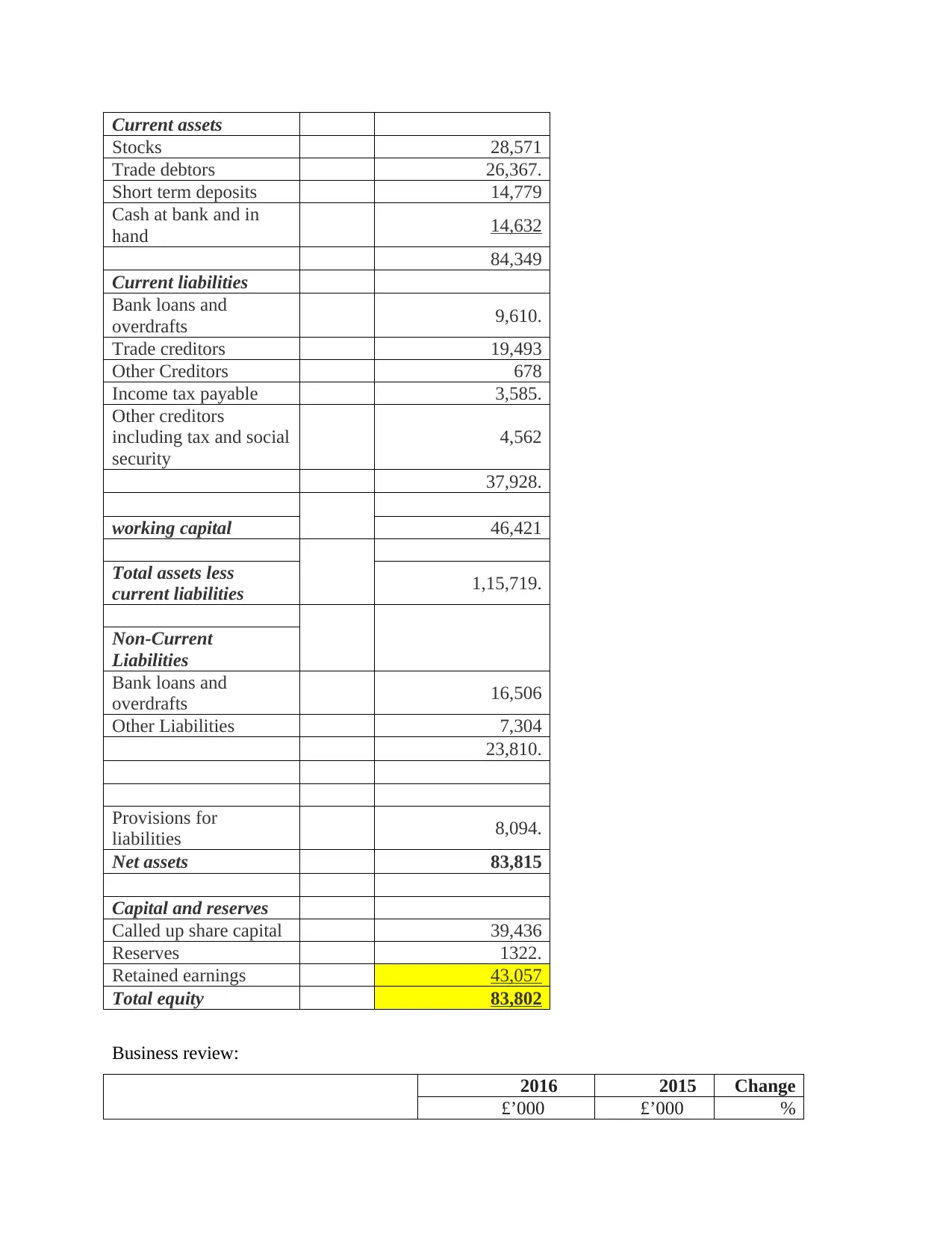
Current assets
Stocks 28,571
Trade debtors 26,367.
Short term deposits 14,779
Cash at bank and in
hand 14,632
84,349
Current liabilities
Bank loans and
overdrafts 9,610.
Trade creditors 19,493
Other Creditors 678
Income tax payable 3,585.
Other creditors
including tax and social
security
4,562
37,928.
working capital 46,421
Total assets less
current liabilities 1,15,719.
Non-Current
Liabilities
Bank loans and
overdrafts 16,506
Other Liabilities 7,304
23,810.
Provisions for
liabilities 8,094.
Net assets 83,815
Capital and reserves
Called up share capital 39,436
Reserves 1322.
Retained earnings 43,057
Total equity 83,802
Business review:
2016 2015 Change
£’000 £’000 %
Stocks 28,571
Trade debtors 26,367.
Short term deposits 14,779
Cash at bank and in
hand 14,632
84,349
Current liabilities
Bank loans and
overdrafts 9,610.
Trade creditors 19,493
Other Creditors 678
Income tax payable 3,585.
Other creditors
including tax and social
security
4,562
37,928.
working capital 46,421
Total assets less
current liabilities 1,15,719.
Non-Current
Liabilities
Bank loans and
overdrafts 16,506
Other Liabilities 7,304
23,810.
Provisions for
liabilities 8,094.
Net assets 83,815
Capital and reserves
Called up share capital 39,436
Reserves 1322.
Retained earnings 43,057
Total equity 83,802
Business review:
2016 2015 Change
£’000 £’000 %
⊘ This is a preview!⊘
Do you want full access?
Subscribe today to unlock all pages.

Trusted by 1+ million students worldwide
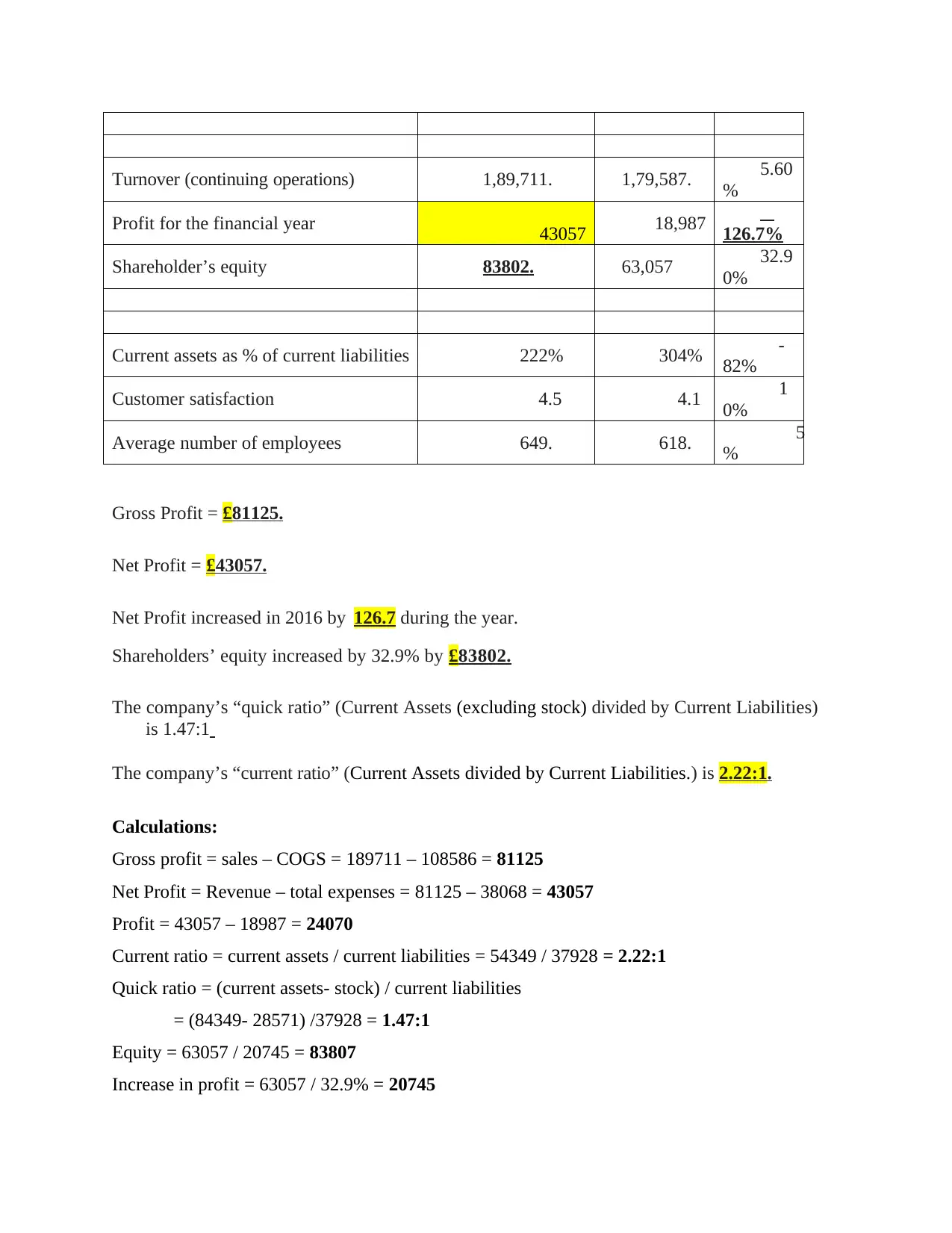
Turnover (continuing operations) 1,89,711. 1,79,587. 5.60
%
Profit for the financial year 43057 18,987 126.7%
Shareholder’s equity 83802. 63,057 32.9
0%
Current assets as % of current liabilities 222% 304% -
82%
Customer satisfaction 4.5 4.1 1
0%
Average number of employees 649. 618. 5
%
Gross Profit = £81125.
Net Profit = £43057.
Net Profit increased in 2016 by 126.7 during the year.
Shareholders’ equity increased by 32.9% by £83802.
The company’s “quick ratio” (Current Assets (excluding stock) divided by Current Liabilities)
is 1.47:1
The company’s “current ratio” (Current Assets divided by Current Liabilities.) is 2.22:1.
Calculations:
Gross profit = sales – COGS = 189711 – 108586 = 81125
Net Profit = Revenue – total expenses = 81125 – 38068 = 43057
Profit = 43057 – 18987 = 24070
Current ratio = current assets / current liabilities = 54349 / 37928 = 2.22:1
Quick ratio = (current assets- stock) / current liabilities
= (84349- 28571) /37928 = 1.47:1
Equity = 63057 / 20745 = 83807
Increase in profit = 63057 / 32.9% = 20745
%
Profit for the financial year 43057 18,987 126.7%
Shareholder’s equity 83802. 63,057 32.9
0%
Current assets as % of current liabilities 222% 304% -
82%
Customer satisfaction 4.5 4.1 1
0%
Average number of employees 649. 618. 5
%
Gross Profit = £81125.
Net Profit = £43057.
Net Profit increased in 2016 by 126.7 during the year.
Shareholders’ equity increased by 32.9% by £83802.
The company’s “quick ratio” (Current Assets (excluding stock) divided by Current Liabilities)
is 1.47:1
The company’s “current ratio” (Current Assets divided by Current Liabilities.) is 2.22:1.
Calculations:
Gross profit = sales – COGS = 189711 – 108586 = 81125
Net Profit = Revenue – total expenses = 81125 – 38068 = 43057
Profit = 43057 – 18987 = 24070
Current ratio = current assets / current liabilities = 54349 / 37928 = 2.22:1
Quick ratio = (current assets- stock) / current liabilities
= (84349- 28571) /37928 = 1.47:1
Equity = 63057 / 20745 = 83807
Increase in profit = 63057 / 32.9% = 20745
Paraphrase This Document
Need a fresh take? Get an instant paraphrase of this document with our AI Paraphraser
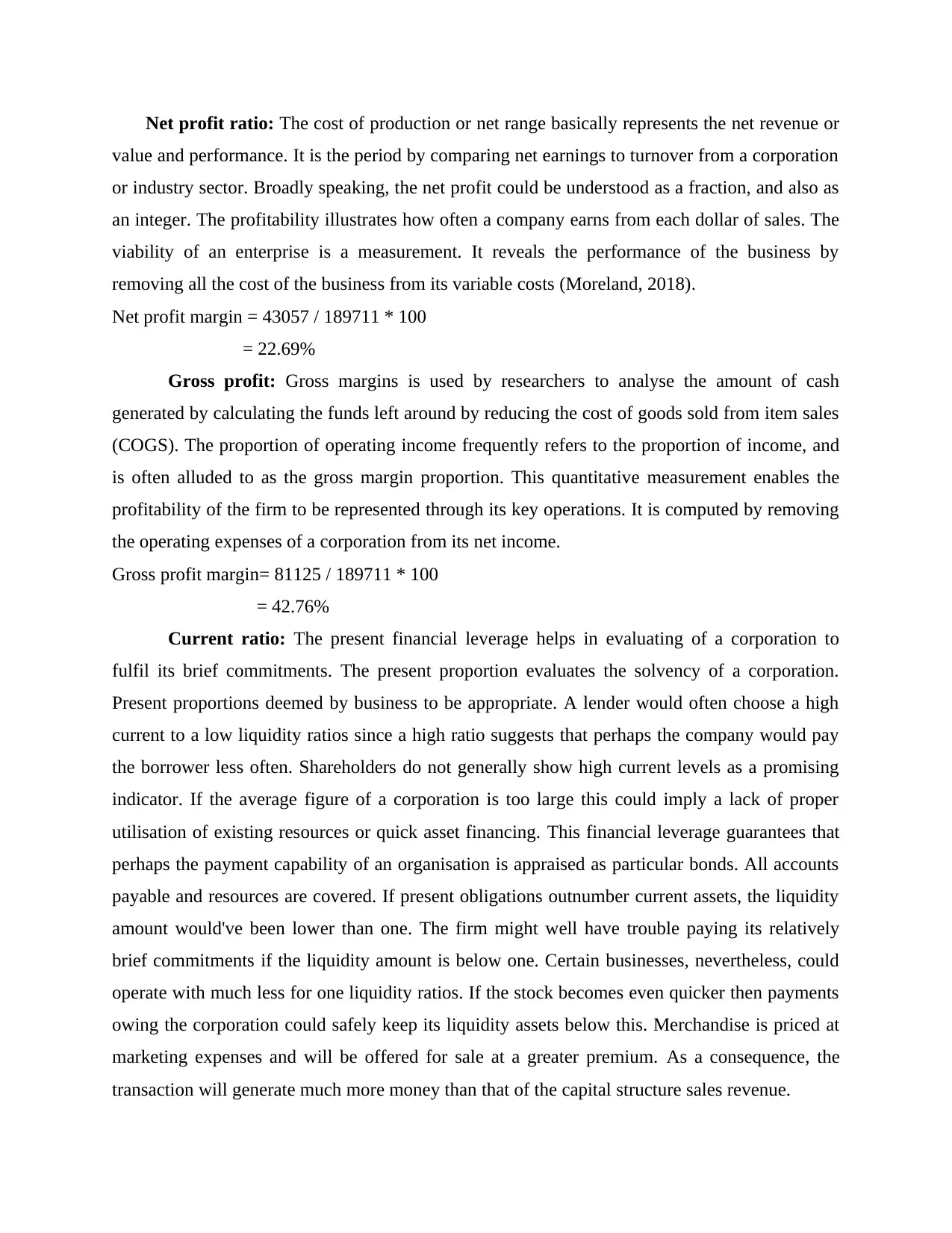
Net profit ratio: The cost of production or net range basically represents the net revenue or
value and performance. It is the period by comparing net earnings to turnover from a corporation
or industry sector. Broadly speaking, the net profit could be understood as a fraction, and also as
an integer. The profitability illustrates how often a company earns from each dollar of sales. The
viability of an enterprise is a measurement. It reveals the performance of the business by
removing all the cost of the business from its variable costs (Moreland, 2018).
Net profit margin = 43057 / 189711 * 100
= 22.69%
Gross profit: Gross margins is used by researchers to analyse the amount of cash
generated by calculating the funds left around by reducing the cost of goods sold from item sales
(COGS). The proportion of operating income frequently refers to the proportion of income, and
is often alluded to as the gross margin proportion. This quantitative measurement enables the
profitability of the firm to be represented through its key operations. It is computed by removing
the operating expenses of a corporation from its net income.
Gross profit margin= 81125 / 189711 * 100
= 42.76%
Current ratio: The present financial leverage helps in evaluating of a corporation to
fulfil its brief commitments. The present proportion evaluates the solvency of a corporation.
Present proportions deemed by business to be appropriate. A lender would often choose a high
current to a low liquidity ratios since a high ratio suggests that perhaps the company would pay
the borrower less often. Shareholders do not generally show high current levels as a promising
indicator. If the average figure of a corporation is too large this could imply a lack of proper
utilisation of existing resources or quick asset financing. This financial leverage guarantees that
perhaps the payment capability of an organisation is appraised as particular bonds. All accounts
payable and resources are covered. If present obligations outnumber current assets, the liquidity
amount would've been lower than one. The firm might well have trouble paying its relatively
brief commitments if the liquidity amount is below one. Certain businesses, nevertheless, could
operate with much less for one liquidity ratios. If the stock becomes even quicker then payments
owing the corporation could safely keep its liquidity assets below this. Merchandise is priced at
marketing expenses and will be offered for sale at a greater premium. As a consequence, the
transaction will generate much more money than that of the capital structure sales revenue.
value and performance. It is the period by comparing net earnings to turnover from a corporation
or industry sector. Broadly speaking, the net profit could be understood as a fraction, and also as
an integer. The profitability illustrates how often a company earns from each dollar of sales. The
viability of an enterprise is a measurement. It reveals the performance of the business by
removing all the cost of the business from its variable costs (Moreland, 2018).
Net profit margin = 43057 / 189711 * 100
= 22.69%
Gross profit: Gross margins is used by researchers to analyse the amount of cash
generated by calculating the funds left around by reducing the cost of goods sold from item sales
(COGS). The proportion of operating income frequently refers to the proportion of income, and
is often alluded to as the gross margin proportion. This quantitative measurement enables the
profitability of the firm to be represented through its key operations. It is computed by removing
the operating expenses of a corporation from its net income.
Gross profit margin= 81125 / 189711 * 100
= 42.76%
Current ratio: The present financial leverage helps in evaluating of a corporation to
fulfil its brief commitments. The present proportion evaluates the solvency of a corporation.
Present proportions deemed by business to be appropriate. A lender would often choose a high
current to a low liquidity ratios since a high ratio suggests that perhaps the company would pay
the borrower less often. Shareholders do not generally show high current levels as a promising
indicator. If the average figure of a corporation is too large this could imply a lack of proper
utilisation of existing resources or quick asset financing. This financial leverage guarantees that
perhaps the payment capability of an organisation is appraised as particular bonds. All accounts
payable and resources are covered. If present obligations outnumber current assets, the liquidity
amount would've been lower than one. The firm might well have trouble paying its relatively
brief commitments if the liquidity amount is below one. Certain businesses, nevertheless, could
operate with much less for one liquidity ratios. If the stock becomes even quicker then payments
owing the corporation could safely keep its liquidity assets below this. Merchandise is priced at
marketing expenses and will be offered for sale at a greater premium. As a consequence, the
transaction will generate much more money than that of the capital structure sales revenue.
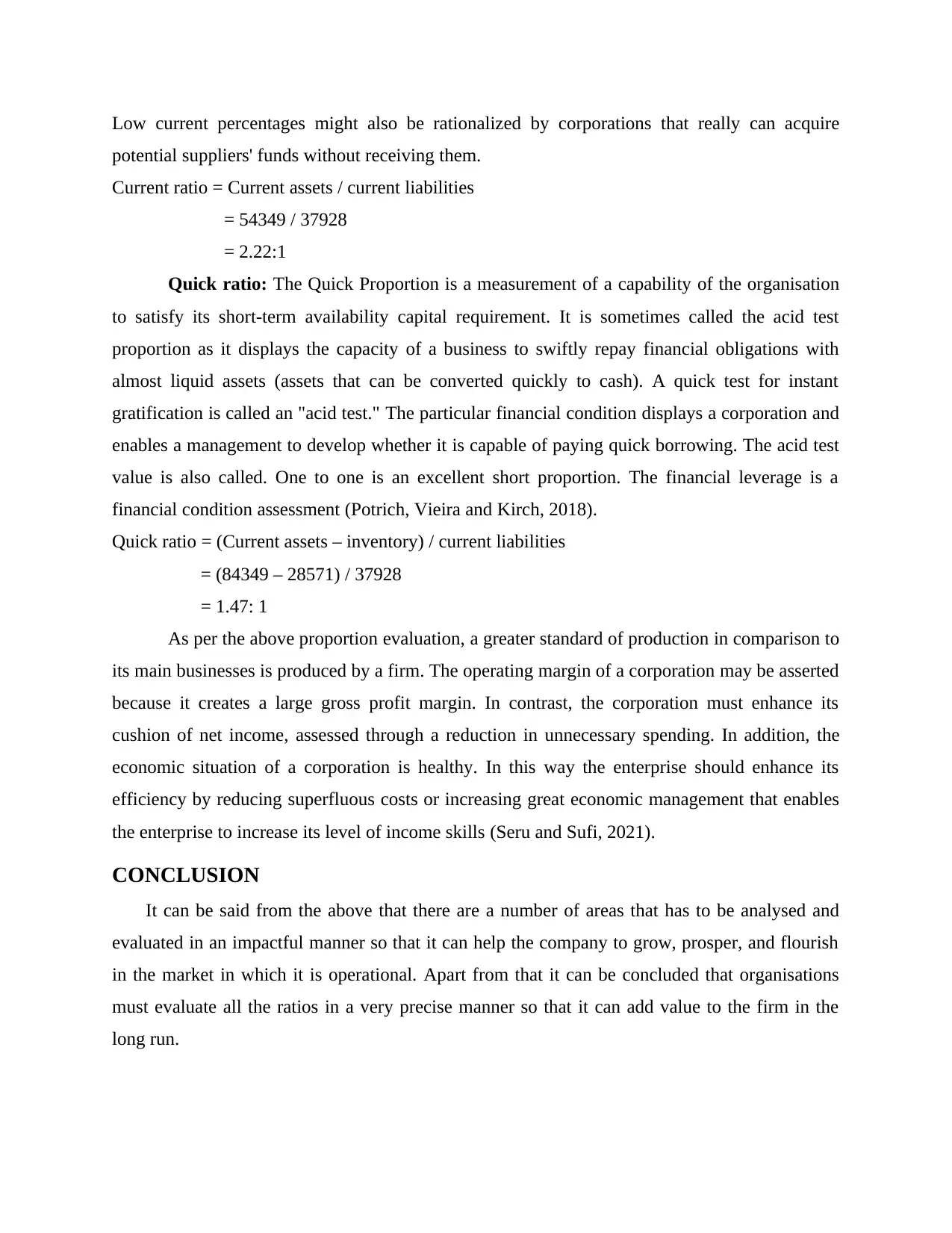
Low current percentages might also be rationalized by corporations that really can acquire
potential suppliers' funds without receiving them.
Current ratio = Current assets / current liabilities
= 54349 / 37928
= 2.22:1
Quick ratio: The Quick Proportion is a measurement of a capability of the organisation
to satisfy its short-term availability capital requirement. It is sometimes called the acid test
proportion as it displays the capacity of a business to swiftly repay financial obligations with
almost liquid assets (assets that can be converted quickly to cash). A quick test for instant
gratification is called an "acid test." The particular financial condition displays a corporation and
enables a management to develop whether it is capable of paying quick borrowing. The acid test
value is also called. One to one is an excellent short proportion. The financial leverage is a
financial condition assessment (Potrich, Vieira and Kirch, 2018).
Quick ratio = (Current assets – inventory) / current liabilities
= (84349 – 28571) / 37928
= 1.47: 1
As per the above proportion evaluation, a greater standard of production in comparison to
its main businesses is produced by a firm. The operating margin of a corporation may be asserted
because it creates a large gross profit margin. In contrast, the corporation must enhance its
cushion of net income, assessed through a reduction in unnecessary spending. In addition, the
economic situation of a corporation is healthy. In this way the enterprise should enhance its
efficiency by reducing superfluous costs or increasing great economic management that enables
the enterprise to increase its level of income skills (Seru and Sufi, 2021).
CONCLUSION
It can be said from the above that there are a number of areas that has to be analysed and
evaluated in an impactful manner so that it can help the company to grow, prosper, and flourish
in the market in which it is operational. Apart from that it can be concluded that organisations
must evaluate all the ratios in a very precise manner so that it can add value to the firm in the
long run.
potential suppliers' funds without receiving them.
Current ratio = Current assets / current liabilities
= 54349 / 37928
= 2.22:1
Quick ratio: The Quick Proportion is a measurement of a capability of the organisation
to satisfy its short-term availability capital requirement. It is sometimes called the acid test
proportion as it displays the capacity of a business to swiftly repay financial obligations with
almost liquid assets (assets that can be converted quickly to cash). A quick test for instant
gratification is called an "acid test." The particular financial condition displays a corporation and
enables a management to develop whether it is capable of paying quick borrowing. The acid test
value is also called. One to one is an excellent short proportion. The financial leverage is a
financial condition assessment (Potrich, Vieira and Kirch, 2018).
Quick ratio = (Current assets – inventory) / current liabilities
= (84349 – 28571) / 37928
= 1.47: 1
As per the above proportion evaluation, a greater standard of production in comparison to
its main businesses is produced by a firm. The operating margin of a corporation may be asserted
because it creates a large gross profit margin. In contrast, the corporation must enhance its
cushion of net income, assessed through a reduction in unnecessary spending. In addition, the
economic situation of a corporation is healthy. In this way the enterprise should enhance its
efficiency by reducing superfluous costs or increasing great economic management that enables
the enterprise to increase its level of income skills (Seru and Sufi, 2021).
CONCLUSION
It can be said from the above that there are a number of areas that has to be analysed and
evaluated in an impactful manner so that it can help the company to grow, prosper, and flourish
in the market in which it is operational. Apart from that it can be concluded that organisations
must evaluate all the ratios in a very precise manner so that it can add value to the firm in the
long run.
⊘ This is a preview!⊘
Do you want full access?
Subscribe today to unlock all pages.

Trusted by 1+ million students worldwide
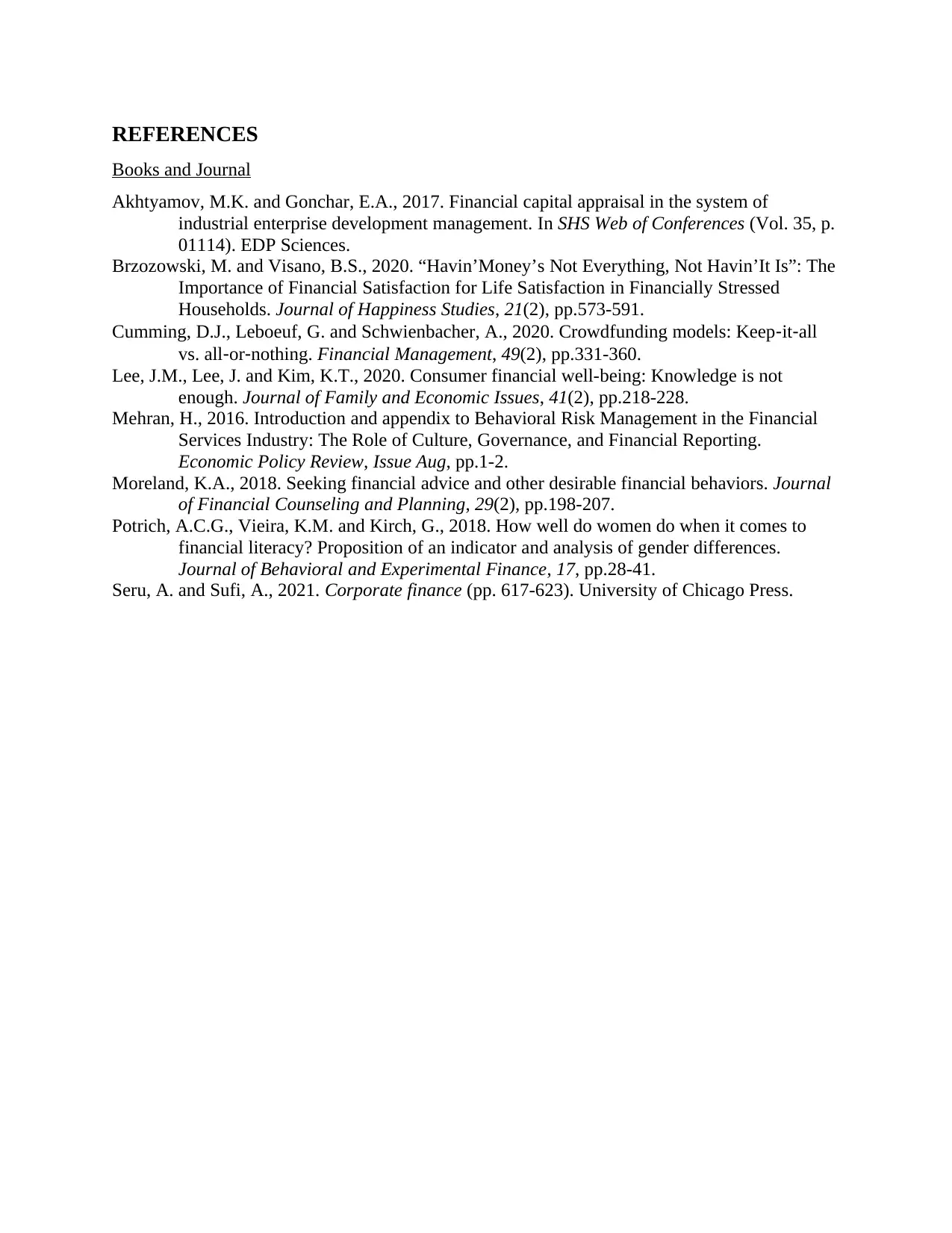
REFERENCES
Books and Journal
Akhtyamov, M.K. and Gonchar, E.A., 2017. Financial capital appraisal in the system of
industrial enterprise development management. In SHS Web of Conferences (Vol. 35, p.
01114). EDP Sciences.
Brzozowski, M. and Visano, B.S., 2020. “Havin’Money’s Not Everything, Not Havin’It Is”: The
Importance of Financial Satisfaction for Life Satisfaction in Financially Stressed
Households. Journal of Happiness Studies, 21(2), pp.573-591.
Cumming, D.J., Leboeuf, G. and Schwienbacher, A., 2020. Crowdfunding models: Keep‐it‐all
vs. all‐or‐nothing. Financial Management, 49(2), pp.331-360.
Lee, J.M., Lee, J. and Kim, K.T., 2020. Consumer financial well-being: Knowledge is not
enough. Journal of Family and Economic Issues, 41(2), pp.218-228.
Mehran, H., 2016. Introduction and appendix to Behavioral Risk Management in the Financial
Services Industry: The Role of Culture, Governance, and Financial Reporting.
Economic Policy Review, Issue Aug, pp.1-2.
Moreland, K.A., 2018. Seeking financial advice and other desirable financial behaviors. Journal
of Financial Counseling and Planning, 29(2), pp.198-207.
Potrich, A.C.G., Vieira, K.M. and Kirch, G., 2018. How well do women do when it comes to
financial literacy? Proposition of an indicator and analysis of gender differences.
Journal of Behavioral and Experimental Finance, 17, pp.28-41.
Seru, A. and Sufi, A., 2021. Corporate finance (pp. 617-623). University of Chicago Press.
Books and Journal
Akhtyamov, M.K. and Gonchar, E.A., 2017. Financial capital appraisal in the system of
industrial enterprise development management. In SHS Web of Conferences (Vol. 35, p.
01114). EDP Sciences.
Brzozowski, M. and Visano, B.S., 2020. “Havin’Money’s Not Everything, Not Havin’It Is”: The
Importance of Financial Satisfaction for Life Satisfaction in Financially Stressed
Households. Journal of Happiness Studies, 21(2), pp.573-591.
Cumming, D.J., Leboeuf, G. and Schwienbacher, A., 2020. Crowdfunding models: Keep‐it‐all
vs. all‐or‐nothing. Financial Management, 49(2), pp.331-360.
Lee, J.M., Lee, J. and Kim, K.T., 2020. Consumer financial well-being: Knowledge is not
enough. Journal of Family and Economic Issues, 41(2), pp.218-228.
Mehran, H., 2016. Introduction and appendix to Behavioral Risk Management in the Financial
Services Industry: The Role of Culture, Governance, and Financial Reporting.
Economic Policy Review, Issue Aug, pp.1-2.
Moreland, K.A., 2018. Seeking financial advice and other desirable financial behaviors. Journal
of Financial Counseling and Planning, 29(2), pp.198-207.
Potrich, A.C.G., Vieira, K.M. and Kirch, G., 2018. How well do women do when it comes to
financial literacy? Proposition of an indicator and analysis of gender differences.
Journal of Behavioral and Experimental Finance, 17, pp.28-41.
Seru, A. and Sufi, A., 2021. Corporate finance (pp. 617-623). University of Chicago Press.
Paraphrase This Document
Need a fresh take? Get an instant paraphrase of this document with our AI Paraphraser
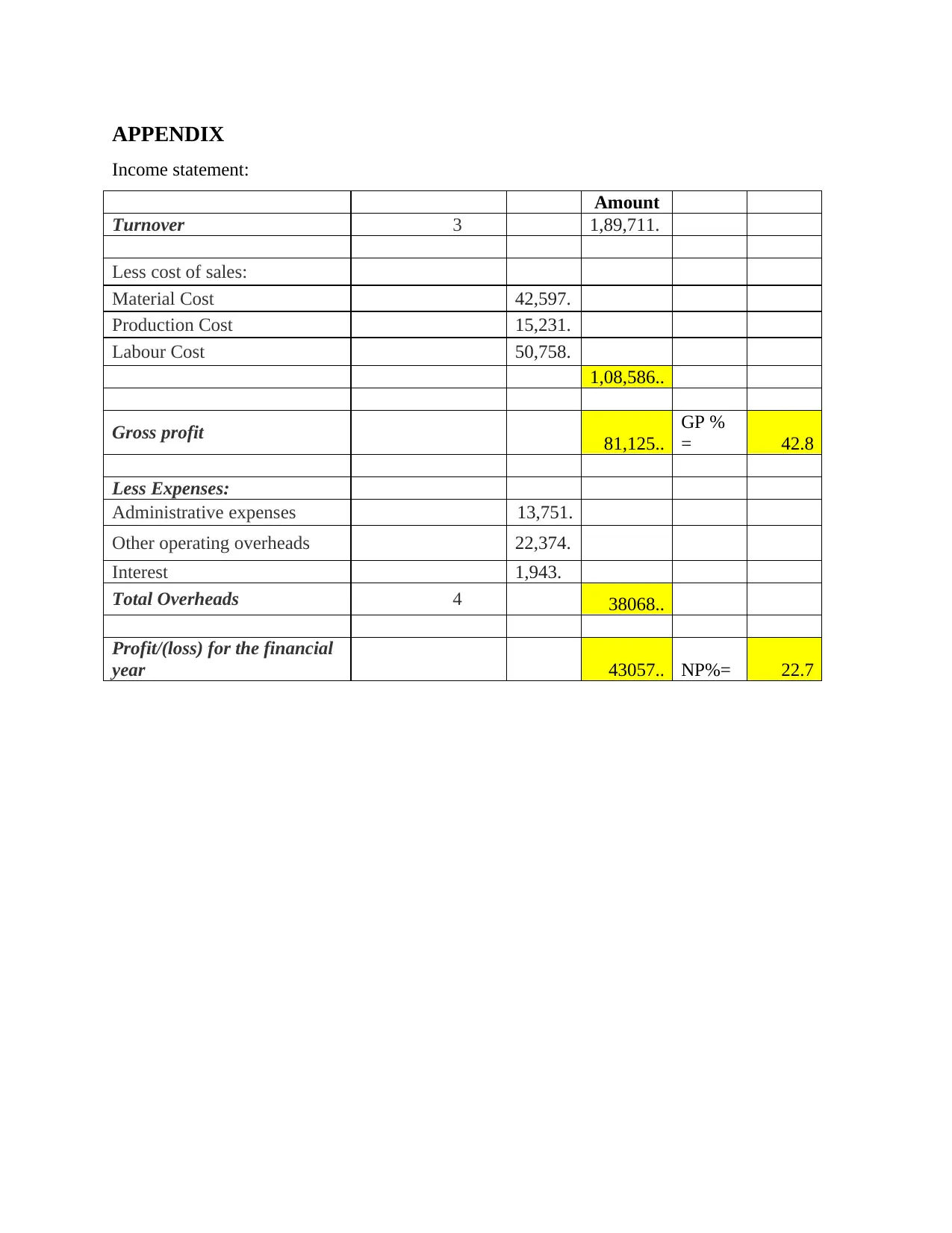
APPENDIX
Income statement:
Amount
Turnover 3 1,89,711.
Less cost of sales:
Material Cost 42,597.
Production Cost 15,231.
Labour Cost 50,758.
1,08,586..
Gross profit 81,125..
GP %
= 42.8
Less Expenses:
Administrative expenses 13,751.
Other operating overheads 22,374.
Interest 1,943.
Total Overheads 4 38068..
Profit/(loss) for the financial
year 43057.. NP%= 22.7
Income statement:
Amount
Turnover 3 1,89,711.
Less cost of sales:
Material Cost 42,597.
Production Cost 15,231.
Labour Cost 50,758.
1,08,586..
Gross profit 81,125..
GP %
= 42.8
Less Expenses:
Administrative expenses 13,751.
Other operating overheads 22,374.
Interest 1,943.
Total Overheads 4 38068..
Profit/(loss) for the financial
year 43057.. NP%= 22.7
1 out of 11
Related Documents
Your All-in-One AI-Powered Toolkit for Academic Success.
+13062052269
info@desklib.com
Available 24*7 on WhatsApp / Email
![[object Object]](/_next/static/media/star-bottom.7253800d.svg)
Unlock your academic potential
Copyright © 2020–2025 A2Z Services. All Rights Reserved. Developed and managed by ZUCOL.





